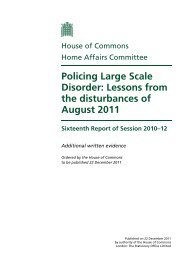Murder and Serious Sexual Assault - Lancaster EPrints - Lancaster ...
Murder and Serious Sexual Assault - Lancaster EPrints - Lancaster ...
Murder and Serious Sexual Assault - Lancaster EPrints - Lancaster ...
You also want an ePaper? Increase the reach of your titles
YUMPU automatically turns print PDFs into web optimized ePapers that Google loves.
APPENDIX C<br />
In total, therefore, 13 variables contributed to the risk score for murder. Eight of the<br />
summary measures produced an increased risk (shown by a positive estimate in<br />
column 2 <strong>and</strong> a relative risk contribution above one in column 4); five summary<br />
measures lowered the risk (shown by a negative estimate in column 2 <strong>and</strong> a relative<br />
risk contribution below one in column 4). Some of the unusual offences identified<br />
in Table 6 are not present in the risk score. Kidnapping <strong>and</strong> blackmail are both<br />
missing from the final score, as such activity does not further significantly change<br />
the risk of murder once the chosen thirteen variables have been allowed for.<br />
However, manslaughter increases the risk of murder by a factor of over eleven times,<br />
even after controlling for the two offence codes of violence. Similarly, attempting to<br />
pervert the course of justice (offence code 79) significantly reduced the risk of<br />
murder by over seven times, even after controlling for other variables.<br />
Interpretation<br />
The estimates in the above table can be used to build a relative risk for subsequent<br />
murder for any offender with a prior conviction. In order to consider what such a<br />
score is relative to, it is necessary to define a typical ‘baseline’ offender with none of<br />
the criminal career characteristics appearing in the above table. Such an offender is<br />
allowed to have one or more prior convictions for any offences not appearing in<br />
Table 17 (the ‘murder-neutral’ offences) which have not led to a custodial sentence<br />
on the last sentencing occasion, but should have no convictions for any of the<br />
offences which do appear in the above table. These ‘murder-neutral’ offences would<br />
include, for example, burglary in a dwelling, shoplifting <strong>and</strong> car crime. We can<br />
imagine this baseline offender to be a typical petty offender, with a string of<br />
relatively minor offences that have not led to a custodial sentence.<br />
Compared with this typical petty offender, it is possible to calculate a relative risk of<br />
murder for any other offender. If any of the risk factors above appear in the criminal<br />
history of the offender, then we multiply the relative risks together. If none of the risk<br />
factors appear, then the relative risk would be 1.0. One example is considered below:<br />
Example A. A 25-year-old active offender with prior offences for arson, actual<br />
bodily harm <strong>and</strong> indecent assault of a female. This last offence leading to a<br />
custodial sentence of six months.<br />
The offence of arson has a relative risk contribution of 1.987; the offence of actual<br />
bodily harm belongs in offence category 8 – other wounding etc. – which has a<br />
relative risk contribution of 1.329. The offence of indecent assault of a female is<br />
58
















